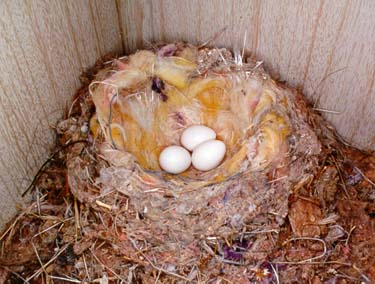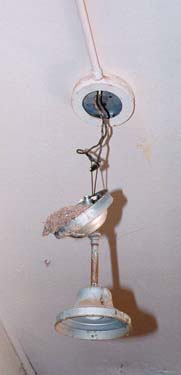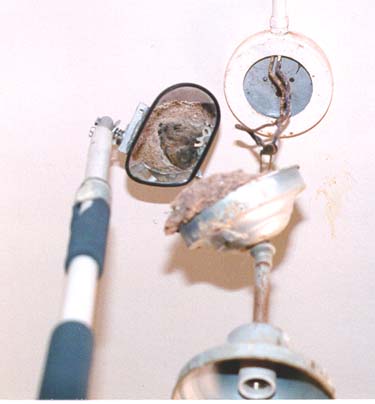Say's Phoebe Nest with Eggs and Young Photographs
Photos by Greg Clark, May 15, 1999
 Say's Phoebe is one of the birds that has gained from human activities. Although its range includes most of western North America, it was historically a very unusual bird to see. Nesting in caves and natural formations that provided a flat bottom and overhang above, the Say's Phoebe would build its nests in remote areas where people would rarely go. Unlike other Phoebes (like the Black Phoebe) this bird does not use mud to "glue" its nest to a wall for support. Instead the nest is made using the softest materials available. This requires that a solid foundation be available to hold the nest. When humans arrived in the west they built structures with roofs and walls that sometimes had spaces between the roof and the wall. A house with a roof overhang is basically a "nest box" for Say's Phoebe if a small space near the roof is available. As a result, the Say's Phoebe was able to expand away from mountains with caves into rural and residential areas with ample nesting habitat. (Once Tim found a Say's Phoebe nest inside a Cliff Swallow mud cavity. It met all the criteria for solid foundation and overhang, but who would expect to look in old Cliff Swallow nest colonies for active nests of flycatchers?). We have found many nests in manmade structures over the last six years and the two photographic examples here exemplify the adaptability of this opportunist insect eating flycatcher. The first nest was found in an unused mobile home with modern carpets, bathrooms, built-in appliances and a bedroom with a hole in one of the windows. The nest shown above is built on the top shelf of a clothes closet in the bedroom with the broken window. If the last occupants had left the closet door closed, it would have deprived the bird of this extremely dry, comfortable, and safe nest site. Note the variety and color of the different materials used to construct the nest. Like the Bendire's Thrasher nest (found on another page on this site) this bird used a piece of blue plastic tarp in the nest. (The Bendire's nest was full of the stuff, this bird only used one piece around the top edge).
Say's Phoebe is one of the birds that has gained from human activities. Although its range includes most of western North America, it was historically a very unusual bird to see. Nesting in caves and natural formations that provided a flat bottom and overhang above, the Say's Phoebe would build its nests in remote areas where people would rarely go. Unlike other Phoebes (like the Black Phoebe) this bird does not use mud to "glue" its nest to a wall for support. Instead the nest is made using the softest materials available. This requires that a solid foundation be available to hold the nest. When humans arrived in the west they built structures with roofs and walls that sometimes had spaces between the roof and the wall. A house with a roof overhang is basically a "nest box" for Say's Phoebe if a small space near the roof is available. As a result, the Say's Phoebe was able to expand away from mountains with caves into rural and residential areas with ample nesting habitat. (Once Tim found a Say's Phoebe nest inside a Cliff Swallow mud cavity. It met all the criteria for solid foundation and overhang, but who would expect to look in old Cliff Swallow nest colonies for active nests of flycatchers?). We have found many nests in manmade structures over the last six years and the two photographic examples here exemplify the adaptability of this opportunist insect eating flycatcher. The first nest was found in an unused mobile home with modern carpets, bathrooms, built-in appliances and a bedroom with a hole in one of the windows. The nest shown above is built on the top shelf of a clothes closet in the bedroom with the broken window. If the last occupants had left the closet door closed, it would have deprived the bird of this extremely dry, comfortable, and safe nest site. Note the variety and color of the different materials used to construct the nest. Like the Bendire's Thrasher nest (found on another page on this site) this bird used a piece of blue plastic tarp in the nest. (The Bendire's nest was full of the stuff, this bird only used one piece around the top edge).
 No abandoned mobile homes available for nest sites? Consider a hanging light fixture in an abandoned school room instead. This has the added advantage of the cup in the fixture to support the nest sides! Note that the fixture is tilted at an angle but the bird has built a level nest. When the wind blows real hard this nest will swing in all directions (whee!).
No abandoned mobile homes available for nest sites? Consider a hanging light fixture in an abandoned school room instead. This has the added advantage of the cup in the fixture to support the nest sides! Note that the fixture is tilted at an angle but the bird has built a level nest. When the wind blows real hard this nest will swing in all directions (whee!).
The baby birds are shown in the mirror-pole in the bottom photo.

mirror-pole.com home
Copyright Greg Clark, 1999
 Say's Phoebe is one of the birds that has gained from human activities. Although its range includes most of western North America, it was historically a very unusual bird to see. Nesting in caves and natural formations that provided a flat bottom and overhang above, the Say's Phoebe would build its nests in remote areas where people would rarely go. Unlike other Phoebes (like the Black Phoebe) this bird does not use mud to "glue" its nest to a wall for support. Instead the nest is made using the softest materials available. This requires that a solid foundation be available to hold the nest. When humans arrived in the west they built structures with roofs and walls that sometimes had spaces between the roof and the wall. A house with a roof overhang is basically a "nest box" for Say's Phoebe if a small space near the roof is available. As a result, the Say's Phoebe was able to expand away from mountains with caves into rural and residential areas with ample nesting habitat. (Once Tim found a Say's Phoebe nest inside a Cliff Swallow mud cavity. It met all the criteria for solid foundation and overhang, but who would expect to look in old Cliff Swallow nest colonies for active nests of flycatchers?). We have found many nests in manmade structures over the last six years and the two photographic examples here exemplify the adaptability of this opportunist insect eating flycatcher. The first nest was found in an unused mobile home with modern carpets, bathrooms, built-in appliances and a bedroom with a hole in one of the windows. The nest shown above is built on the top shelf of a clothes closet in the bedroom with the broken window. If the last occupants had left the closet door closed, it would have deprived the bird of this extremely dry, comfortable, and safe nest site. Note the variety and color of the different materials used to construct the nest. Like the Bendire's Thrasher nest (found on another page on this site) this bird used a piece of blue plastic tarp in the nest. (The Bendire's nest was full of the stuff, this bird only used one piece around the top edge).
Say's Phoebe is one of the birds that has gained from human activities. Although its range includes most of western North America, it was historically a very unusual bird to see. Nesting in caves and natural formations that provided a flat bottom and overhang above, the Say's Phoebe would build its nests in remote areas where people would rarely go. Unlike other Phoebes (like the Black Phoebe) this bird does not use mud to "glue" its nest to a wall for support. Instead the nest is made using the softest materials available. This requires that a solid foundation be available to hold the nest. When humans arrived in the west they built structures with roofs and walls that sometimes had spaces between the roof and the wall. A house with a roof overhang is basically a "nest box" for Say's Phoebe if a small space near the roof is available. As a result, the Say's Phoebe was able to expand away from mountains with caves into rural and residential areas with ample nesting habitat. (Once Tim found a Say's Phoebe nest inside a Cliff Swallow mud cavity. It met all the criteria for solid foundation and overhang, but who would expect to look in old Cliff Swallow nest colonies for active nests of flycatchers?). We have found many nests in manmade structures over the last six years and the two photographic examples here exemplify the adaptability of this opportunist insect eating flycatcher. The first nest was found in an unused mobile home with modern carpets, bathrooms, built-in appliances and a bedroom with a hole in one of the windows. The nest shown above is built on the top shelf of a clothes closet in the bedroom with the broken window. If the last occupants had left the closet door closed, it would have deprived the bird of this extremely dry, comfortable, and safe nest site. Note the variety and color of the different materials used to construct the nest. Like the Bendire's Thrasher nest (found on another page on this site) this bird used a piece of blue plastic tarp in the nest. (The Bendire's nest was full of the stuff, this bird only used one piece around the top edge). No abandoned mobile homes available for nest sites? Consider a hanging light fixture in an abandoned school room instead. This has the added advantage of the cup in the fixture to support the nest sides! Note that the fixture is tilted at an angle but the bird has built a level nest. When the wind blows real hard this nest will swing in all directions (whee!).
No abandoned mobile homes available for nest sites? Consider a hanging light fixture in an abandoned school room instead. This has the added advantage of the cup in the fixture to support the nest sides! Note that the fixture is tilted at an angle but the bird has built a level nest. When the wind blows real hard this nest will swing in all directions (whee!).